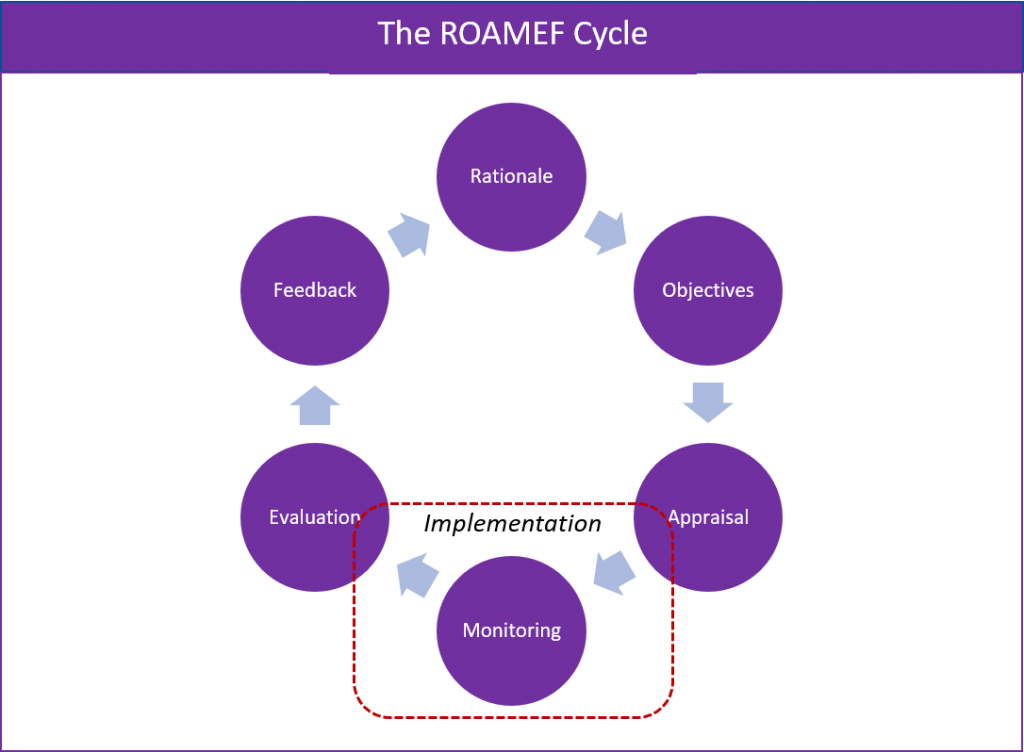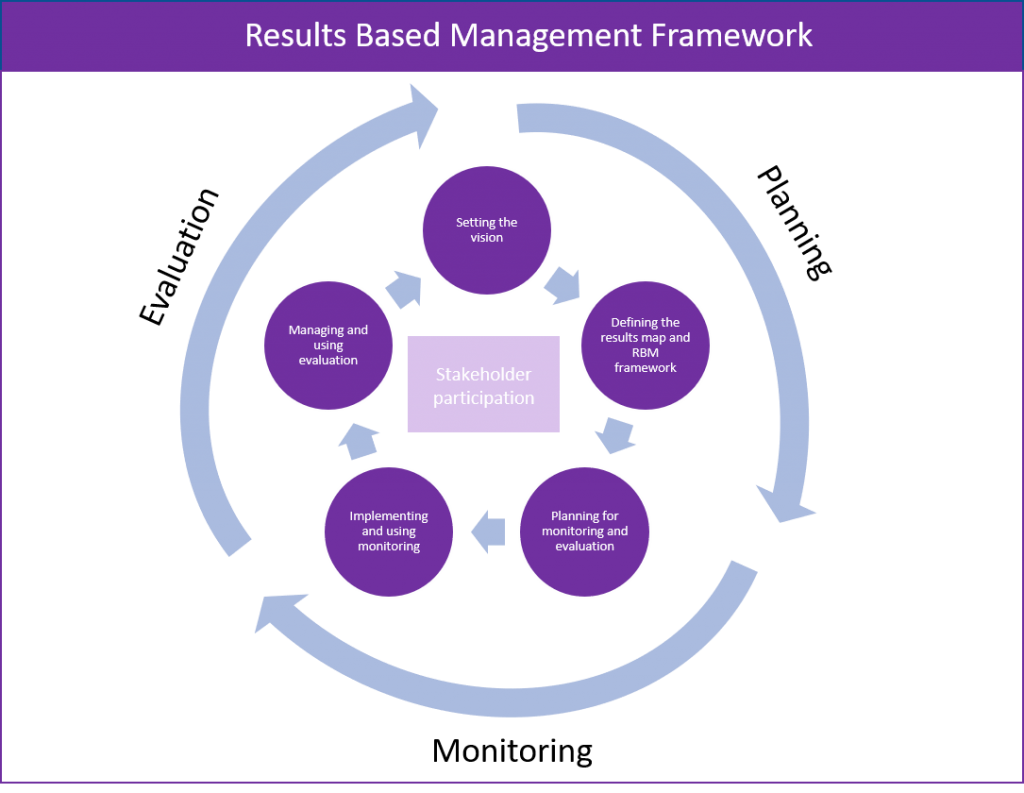Introduction
Welcome to this article on monitoring and evaluation, where we explore more about what monitoring and evaluation is. In addition, we will look at how they work together and the key differences between them. This article is written for non Monitoring and Evaluation specialists and as a result will avoid using a lot of technical language. If you would like to refer to technical guides the OECD and World Bank are great places to go for more information. You can also refer to our course catalog where we are always creating and adding new courses.
What is monitoring and evaluation?
Monitoring and Evaluation at its core is all about improving performance.Its done through gathering information, forming judgments about that information and taking action based on the results.
If we take these three things in turn then what do we mean?
1) Gathering information – One of the key elements of both monitoring and evaluation is in the collecting of information (or more accurately data). Effective monitoring and evaluation often involves a combination of numerical data e.g. number of attendees at a workshop and non-numerical e.g. written feedback from a focus group to help create a picture of what is happening or happened.
2) Forming judgments – Data we receive doesn’t mean much on its own. In order to use it to make decisions we need to form judgments around what the values mean. For example, if we know that your staff have spent 30 hours of time and £10,000 on marketing of a new project is that good or bad? That will entirely depend on what resources you have planned to use on the project, the size and scale of the project, how much of the work you have achieved to date and what is left outstanding. It is therefore important to always make an assessment of what the data you collect actually means.
3) Taking action – Using the judgments or assessments you’ve made to make decisions about how to proceed.
How do monitoring and evaluation fit in with the life cycle of your organisation?
In order to understand the difference between monitoring and evaluation, its important to first understand the broader context in which we choose to use them. Most organisations will follow a similar pattern or cycle as follows:
- Identify the long term goals or mission of your organisation
- Create a strategy or action plan for how you will deliver those long term goals. This is normally through a set of projects each with their own objectives of what it will deliver which will contribute to the overall goal.
- Implement the projects
- Review and adjust the strategy based on project results.
All of this might be done officially through the use of various frameworks, planning documents and approvals process or it might be unofficial as well. We have put two frameworks below, both of which refer to monitoring and evaluation, to help guide our discussion, but these certainly aren’t the only two options. You might be using a different framework altogether.
Frameworks using monitoring and evaluation

The ROAMEF Cycle
The ROAMEF Policy cycle is a defined process for policy development. In it you can see that the overall structure of the policy cycle should be to:
- Develop a rationale for the intervention,
- Decide on your objectives,
- Carry out an appraisal or options analysis to decide what is the best course of action to achieve your objectives,
- Implement and monitor the project,
- Evaluate the project,
- Create feedback which will then influence the rationale and so it continues.

Results Based Management Framework
The Results Based Management Framework uses different language to the ROAMEF cycle but as you can see the pattern is broadly the same:
- Set the vision
- Define a results map
- Plan for monitoring and evaluation
- Implement and use monitoring
- Manage and use evaluation
- Use the results of the evaluation to feedback to the vision.
What is the main difference between monitoring and evaluation?
As you can see from both of these frameworks, the primary difference between monitoring and evaluation is where they sit in the life cycle of your organisation and what decisions they will support you in making. For both monitoring and evaluation you will be:
- Collecting Data
- Forming Judgments
- Making Decisions
Decision making from monitoring data
Decision making from evaluation data
Summary of differences between Monitoring and Evaluation
From the general discussion above, you can see that there aren’t hard and fast rules about what monitoring includes and what evaluation includes. There is often a great deal of overlap between the data you collect in monitoring and what you need for evaluation. The distinction becomes about how you use that information and what decisions you make off of the back of it. A table of differences can often be helpful to refer to which we will go through now, however, bear in mind that these aren’t finite rules and you shouldn’t find them restrictive. Each organisation and project is unique and as a result you should develop an approach to monitoring and evaluation which suits you, so please don’t feel restricted by these distinctions.
Monitoring
- Normally done by members of the project team as they are implementing the project itself. It might be in the form of project update reports, meetings, quarterly reviews, expenditure reports or time sheets.
- Information from monitoring is predominantly for the benefit of the project team to help them implement their plans more effectively.
- Is focused on what is happening right now to help take in the moment decisions.
- Has a greater focus on inputs, activities and outputs, although can also include elements of measuring outcomes which arise during the time frame of the project. As a result, the data you collect is more likely to be quantitative (numbers based) in nature although may have qualitative elements as well.
- Puts a greater emphasis on making sure that things are being delivered on time and to budget, with the main priority being on assessing whether things are being done right.
- There will normally be some element of monitoring throughout the life of a project.
Evaluation
- Ideally done by individuals outside of the project term and even external to the organisation to provide independence. This does not have to be the case though and on smaller projects/organisations it can be done by the same people as monitoring.
- Information from evaluation is predominantly for the benefit of those stakeholders who are involved in strategic planning for the organisation. They will use the information to guide what programmes or projects are done in the future.
- Is focused on future events and long term planning.
- Has a greater focus on outcomes and impact. As a result, will likely include a carefully balanced combination of quantitative data and qualitative (non-numerical) data.
- Works to assess whether your project has been effective, efficient, impactful, sustainable and relevant, with a priority being on understanding whether we are doing the right things.
- Evaluations will often be done periodically or at key decision points throughout and after a project, for example, at the end of a pilot phase of after the project has finished. With that being said, evaluation is something you should consider throughout the planning and implementing of your project as well. All too often, if it is left to the end of a project you might find it difficult or impossible to gather the data you need. It is, therefore, important to have a plan for evaluation to work to, even though it might not be something you intend to do on a continuous basis.
Conclusion
Ready to create a Theory of Change within your own organisation?
Find out more about our online and blended learning training options below.
Online Training and Webinars
Like this? Read more
5 unique challenges when creating a Theory of Change
The benefits of using a Theory of Change facilitator
Why a Theory of Change can be the start of being a Data Driven organisation



4 thoughts on “Differences Between Monitoring and Evaluation”
This is quite interesting,,am going to graduate in certificate of project monitoring and evaluation management.
Here I saw things I never studied. thank you very much for clarifying the basic concept in monitoring and evaluation.
This is quite interesting..
Quite educative and interesting. This write up really simplified the concept of M& E.
Thank you. We are glad you found the content educational and interesting and we appreciate you taking the time to leave your feedback to let us know about your experience.
Best wishes,
The AiA Team